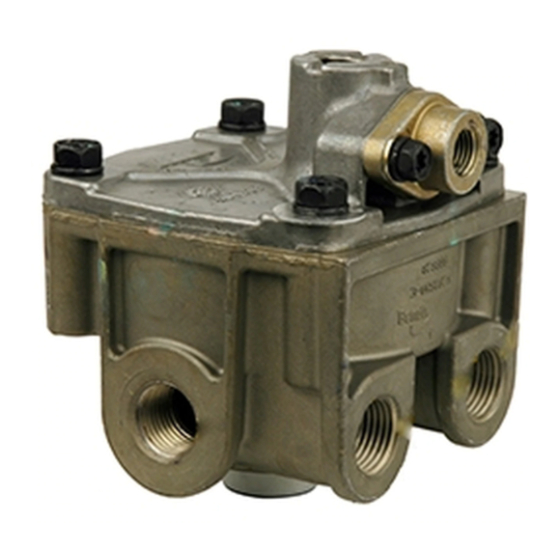BENDIX ATR1DC ANTILOCK TRACTION RELAY Manuel - Page 10
Parcourez en ligne ou téléchargez le pdf Manuel pour {nom_de_la_catégorie} BENDIX ATR1DC ANTILOCK TRACTION RELAY. BENDIX ATR1DC ANTILOCK TRACTION RELAY 12 pages. Antilock traction relay valve
Également pour BENDIX ATR1DC ANTILOCK TRACTION RELAY : Instructions d'installation (4 pages)

DISASSEMBLY
PREPARATION FOR DISASSEMBLY
1. Remove all air fittings and plugs from the valve.
2. Mark the relationship of the valve cover (3) to the body
(4) and, if the valve is equipped with a mounting bracket
(15), mark the relationship of the bracket to the cover
and body (4).
3. Mark the relationship of the electronic controller (1) to
the cover (3).
DISASSEMBLY
The following disassembly and assembly procedure is
presented for reference purposes only. Instructions
packaged with repair and maintenance kits should always
be followed instead of the instructions presented here.
CAUTION: The valve may be lightly clamped in a bench
vise during disassembly, however, over clamping will result
in damage to the valve and result in leakage and/or
malfunction. If a vise is to be used, position the valve so
that the jaws bear on the supply ports on opposing sides
of the valve body.
1. Remove and retain the four cap screws (2) that secure
the electronic controller (1) to the cover (3), then
separate and retain the controller (1), from the cover
(3). Note: In some instances a controller, Item 1, will
not be present and only a cover plate will be noted.
Remove the cover plate in the same manner described
for the controller.
2. While holding the exhaust cover (6), remove the
retaining ring (5) that secures it to the body (4).
3. Remove the exhaust cover( 6) along with both o-rings
(7 & 8).
4. Remove the valve spring (9), valve retainer (10), and
the valve assembly (11) from the body (4).
5. Remove and retain the two long cap screws (12) and
nuts (13) that secure the cover (3) to the body (4).
6. Remove and retain the two cap screws and lock
washers (14) that secure the bracket (15) to the cover
(4), then remove and retain the bracket.
7. Remove and retain the two short cap screws (16) that
secure the cover (3) to the body (4).
8. Separate the cover (3) from the body (4), then remove
the sealing ring (17) and o-ring (18).
9. Remove the relay piston (19) and relay piston spring
(20) from the body (4). NOTE: The relay piston spring,
item 20 is not used in all valves.
10. Remove the o-ring (21) from the relay piston (19).
11. Remove the retaining ring (22). Then remove check valve
seat (23), with o-rings (27 & 28). Remove o-rings (27 &
28) from the check valve seat.
10
12. Remove the check valve (24), guide (25), and spring (26).
13. Remove the inlet seat (29) with o-rings (30 & 31), then
remove o-rings (30 & 31) from the inlet sea (29).
14. Remove the check valve seat (32) from the valve cover
(3). Remove both o-ring (33).
15. Remove the check valve (34), guide (35), and spring (36).
16. Remove the primary inlet seat (37) with o-rings (38, 39 &
40), then remove o-rings (38, 39 & 40) from the primary
inlet seat (37).
17. Do not disassemble the ATR-1DC
described here.
CLEANING & INSPECTION
1. Using mineral spirits or an equivalent solvent, clean and
thoroughly dry all metal parts. Do not damage bores
with metal tools.
2. Wash all retained, nonmetallic components in a soap
and water solution making certain to rinse and dry
thoroughly.
3. Inspect the interior and exterior of all metal parts that
will be reused for severe corrosion, pitting and cracks.
Superficial corrosion and/or pitting on the exterior portion
of the body (4) and cover (3) is acceptable. Replace the
entire valve if the interior of the body or cover exhibit
signs of corrosion or pitting.
4. Inspect each nonmetallic component for cracks, wear
or distortion. Replace the entire valve if these conditions
are found.
5. Inspect the bores of both the body (4) and cover (3) for
deep scuffing or gouges. Replace the entire valve if either
are found.
6. Make certain the air channel running between the top
surface of the body (1) and its supply port is clear and
free of obstruction.
7. Make certain all air channels and exhaust passages in
the valve cover (3) are clear and free of obstruction.
8. Inspect the pipe threads in the body (4) and valve cover
(3). Make certain they are clean and free of thread
sealant.
9. Inspect the relay piston spring (20) for signs of corrosion,
pitting and cracks. Replace as necessary.
10. Inspect all air line fittings for corrosion and replace as
necessary. Make certain to remove all old thread sealant
before reuse.
ASSEMBLY
1. Prior to assembly, lubricate all o-rings, seals, and pistons,
as well as body and cover bores, using silicone lubricant.
2. Install the large and small diameter o-rings (38, 39 & 40)
on the primary inlet seat (37), then insert the small
diameter of the seat (37) into the bore in the cover (3).
Do not cut or pinch the o-rings.
™
valve any further than
